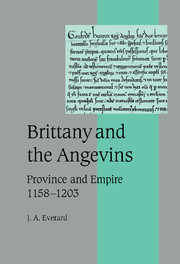Book contents
- Frontmatter
- Contents
- List of figures and maps
- Preface
- List of abbreviations
- Genealogy of the dukes of Brittany, 1066–1203
- The principal political divisions of Brittany, c. 1066
- Ducal domains, c. 1066–1186
- Introduction
- 1 Ducal Brittany, 1066–1166
- 2 Henry II and Brittany
- 3 The government of Brittany under Henry II
- 4 Duke Geoffrey and Brittany, 1166–1186
- 5 Duke Geoffrey, Henry II and the Angevin empire
- 6 The end of Angevin Brittany, 1186–1203
- Conclusion
- Appendices
- 1 The ‘Assize of Count Geoffrey’
- 2 The hereditary seneschals of Rennes
- 3 Angevin officers in Brittany
- 4 The right of Wreck and ducal brefs de mer
- Bibliography
- Index
- Cambridge Studies in Medieval Life and Thought Fourth series
1 - The ‘Assize of Count Geoffrey’
Published online by Cambridge University Press: 15 December 2009
- Frontmatter
- Contents
- List of figures and maps
- Preface
- List of abbreviations
- Genealogy of the dukes of Brittany, 1066–1203
- The principal political divisions of Brittany, c. 1066
- Ducal domains, c. 1066–1186
- Introduction
- 1 Ducal Brittany, 1066–1166
- 2 Henry II and Brittany
- 3 The government of Brittany under Henry II
- 4 Duke Geoffrey and Brittany, 1166–1186
- 5 Duke Geoffrey, Henry II and the Angevin empire
- 6 The end of Angevin Brittany, 1186–1203
- Conclusion
- Appendices
- 1 The ‘Assize of Count Geoffrey’
- 2 The hereditary seneschals of Rennes
- 3 Angevin officers in Brittany
- 4 The right of Wreck and ducal brefs de mer
- Bibliography
- Index
- Cambridge Studies in Medieval Life and Thought Fourth series
Summary
THE MANUSCRIPTS OF THE ASSIZE
The so-called ‘Assize of Count Geoffrey’ was promulgated at a session of the ducal curia held at Rennes in 1185. It was almost certainly promulgated orally in the first instance, then committed to writing, but the history of the written record of the Assize is obscure. Although there are numerous medieval manuscripts of the Assize, no original manuscript has survived, and no two texts are identical.
The written record of the Assize as it now exists consists of seven or eight distinct texts, each addressed to a different baron. The barons to whom these written records of the Assize were addressed are Geoffrey de Châteaubriant, James and Alan de Châteaugiron, Rolland de Dinan, Guihomar de Léon, Eudo de Porhoët, Alan de Rohan and Andrew de Vitré. An eighth text, which lacks an address clause and does not exactly correspond with the other seven texts, may represent a copy of the Assize addressed to an eighth baron whose identity is unknown. It appears that, even in their original manuscript form, these versions all differed slightly, principally in word-order, while recording the same substantive provisions.
It is generally assumed that the documents given to the barons were copies of an original, official text of the Assize, but this assumption is not supported by the evidence. As early as 1212, and having access to the ducal records, Philip Augustus' staff relied upon Alan de Rohan's copy when the French king wanted the text of the Assize recorded in his register of useful documents.
- Type
- Chapter
- Information
- Brittany and the AngevinsProvince and Empire 1158–1203, pp. 182 - 203Publisher: Cambridge University PressPrint publication year: 2000



